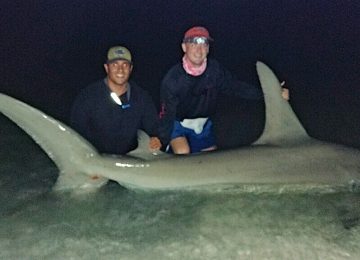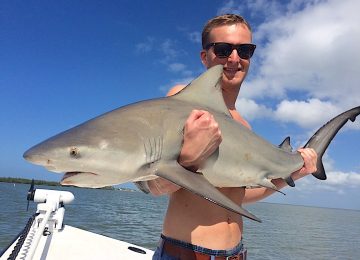Captain Joey’s Youtube Live Stream (Typically Between 8 AM & 4 PM EST)
Current Red Tide & Water Quality Update Here (Page Down For Detail On Sampling & Location Table).
Captiva Fishing: Please Click For Rates & To Book A Captiva Fishing Charter Or Call 239-472-8658.
Live Weather Cams Here.


Sanibel Island Fishing Charters, March 27, 2019
Captain Joey’s Youtube Live Stream (Typically Between 8 AM & 4 PM EST)
Please Click To Rent Homes Direct From Captiva Homeowners; No VRBO Booking Fees.

Captiva Fishing Guide Report: Wednesday, March 27: Atlantic Sharpnose Sharks, Catch & Release, Captain Joe’s Charters – the weather is warming up, the red tide is gone and a lot of good fish have moved back into the gulf, bay and passes; water is much, much better – redfish, sheepshead, black drum, snapper, snook, and seatrout are currently present.
Redfish & snook are regulated as catch & release at this time.
Already seeing some positive impact. Some very nice big redfish and snook around, more big redfish than snook.
The Caloosahatchee freshwater releases are also not an issue right now, but still a huge long-term problem.
Extremely frustrating. We need wholesale changes in the Florida state government. It is not a Republican or Democrat issue – it is a Big Sugar control everyone issue. It is stunning how we continue to let the sugar industry and the agriculture north of Lake Okeechobee to damage the water and all of Florida.
Please click here to Book A Charter or call 239-472-8658.
We’re located in Castaways Marina, Santiva, Sanibel Island, just before the Blind Pass bridge to Captiva Island.

March 27, Sanibel Island Fishing Charters & Sanibel Island Fishing Charters: Atlantic Sharpnose Sharks, Catch & Release. Please also visit the Sanibel, Florida Fishing Report and Cuban Fishing sites.

“The Atlantic sharpnose shark (Rhizoprionodon terraenovae) is a requiem shark in the family Carcharhinidae, found in the subtropical waters of the northwestern Atlantic Ocean, between latitudes 43°N and 18°N.
The Atlantic sharpnose shark is a small shark in comparison to others. The Atlantic sharpnose shark’s maximum species length is known to be about 110–120 cm (3.6–3.9 ft). Although its average adult size tends to be about 91.4–99 cm (3.00–3.25 ft).

Reports exist of these sharks living up to 12 years in the wild. A distinctive feature is that juveniles have black edges on the dorsal and caudal fins.[2]
Atlantic sharpnose sharks can be found as far north as New Brunswick, Canada, to as far south as the southern Gulf of Mexico. Reports of specimens from Brazil are likely being confused with the Brazilian sharpnose shark.
Atlantic sharpnose sharks prefer to live in warmer shallow coastal waters. As they are often found in waters less than 10.1 m (33 ft) deep. Although Atlantic sharpnose reportedly were found at 280 m (920 ft) deep.[2][1][3]

The diet of the Atlantic sharpnose sharks mostly consists of bony fish, worms, shrimp, crabs, and mollusks. Commonly consumed fish include menhaden, eels, silversides, wrasses, jacks, toadfish, and filefish.[2]
Atlantic sharpnose sharks are born ranging from a length of 29–37 cm (11–15 in). For the first three months after birth, they grow an average of 5 cm (2.0 in) per month. Then, in the winter and spring, the average growth rate decreases to 0.9 cm (0.35 in) per month until the shark reaches a length of 60 to 65 cm (24 to 26 in), in which the shark’s growth rate increases linearly about 1.3 cm (0.51 in) per month for about a year.

Males mature at the age of 2–3 years at a length of 80–85 cm (31–33 in), while females seem to mature at the age of 2.5–3.5 years old, at a length around 84–89 cm (33–35 in).[2]
Female Atlantic sharpnose sharks are viviparous and tend to have a litter of four to six pups, but litter size may range from one to seven pups, after a gestation period of 10–11 months. The pups are usually born at between 29 and 37 cm (11 and 15 in) in total length. Females are found in the marine estuaries during the late spring, but they breed mostly throughout the year.[2][1][3]” Please click here for more information and source.

Please click here to Book A Charter or call 239-472-8658 and here for Live Sanibel Traffic Cams. Sunday, May 20, Captiva Island Fishing Charters, Atlantic Sharpnose Shark, Passes & Oyster Bars, click here for College Of Fishing Hats & Apparel.

After a fierce storm, Turner Beach, the beach adjoining the Pass, is frequently covered with a bounty of shells from Olives to Fighting Whelks to the more common Conchs. The fishing is also renowned for sharks in the summer, tailing redfish on the bayside flats and snook under and off the Blind Pass bridge. Because Turner Beach faces Westward, the sunsets are spectacular and a popular viewing point for residents and visitors alike.

We would appreciate if you like us on Facebook.
Fair winds and following seas,
Captain Joey Burnsed ~ please click calendar at the upper right or call 239-472-8658 to book a Sanibel & Captiva Islands, Boca Grande or Fort Myers fishing guide trip or shelling charter.
![Hogfish or Hog Snapper, Sanibel Fishing & Captiva Fishing, Sanibel Island, Sunday, December 10, 2017, [File Photo - Wednesday, February 8, 2017].](https://captivafishing.net/wp-content/uploads/wordpress-popular-posts/13104-featured-360x260.jpg)

![Hogfish or Hog Snapper, Sanibel Fishing & Captiva Fishing, Sanibel Island, Sunday, December 10, 2017, [File Photo - Wednesday, February 8, 2017].](https://captivafishing.net/wp-content/uploads/wordpress-popular-posts/11558-featured-360x260.jpg)







![Goliath grouper, Sanibel & Captiva Islands & Fort Myers Charters & Fishing Guide Service, Thursday, November 2, 2017, [August 16, 2012].](https://captivafishing.net/wp-content/uploads/wordpress-popular-posts/11711-featured-360x260.jpg)



![Hogfish or Hog Snapper, Sanibel Fishing & Captiva Fishing, Sanibel Island, Sunday, December 10, 2017, [File Photo - Wednesday, February 8, 2017].](https://captivafishing.net/wp-content/uploads/wordpress-popular-posts/11143-featured-360x260.jpg)





![Schoolmaster Snapper, Sanibel Fishing & Captiva Fishing, Sanibel Island, Thursday, January 11, 2018, [File Photo - Thursday, December 28, 2017].](https://captivafishing.net/wp-content/uploads/wordpress-popular-posts/13203-featured-360x260.jpg)





















You must be logged in to post a comment.